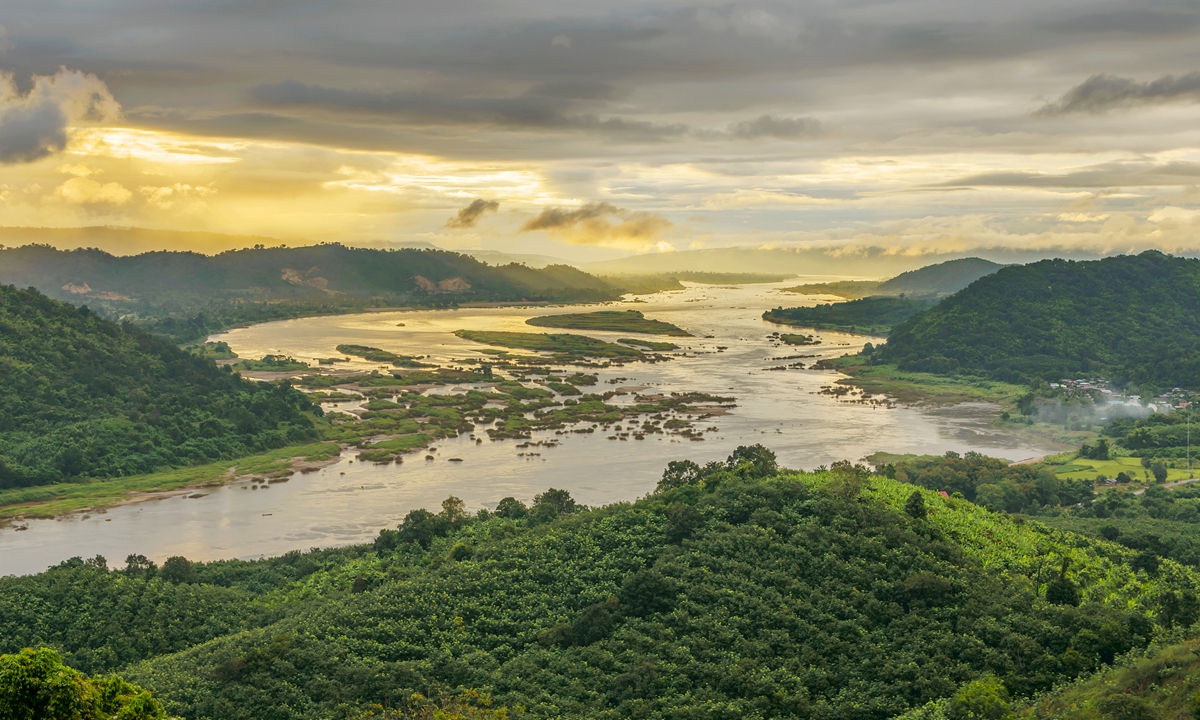Premier Li urges wider Mekong cooperation
By Hu Yuwei Source: Global Times Published: 2020/8/24 20:31:14
Expanded trade channels, vaccine offer sustainable win-win: experts

A view of the Mekong River. Photo: VCG
China brought a series of proposals, including offering the COVID-19 vaccine to Mekong countries as a priority, in the latest move of China's promotion of the Lancang-Mekong Cooperation (LMC), which observers see as a sign of closer ties among the six countries amid the pandemic. The proposals represent expanding cooperation, from water resource sharing to other sectors, analysts said.
China will prioritize providing COVID-19 vaccines to Mekong countries once a vaccine is developed and put into use, Chinese Premier Li Keqiang said at the third Lancang-Mekong Cooperation (LMC) leaders' meeting via video conference on Monday, attended by leaders of six Mekong countries.
To fight the pandemic, China will set up special funds for public health under the framework of the Lancang-Mekong Cooperation Special Fund, and continue to provide Mekong countries with anti-epidemic material and technical support within China's capacity, Li said, adding that China is ready to work with them to support the role of the World Health Organization.
The leaders' video conference, held against the backdrop of the severe epidemic, reflects the urgency and consensus of governments to promote regional cooperation to withstand the COVID-19 headwinds and other challenges, Bi Shihong, a professor at Center for China's Neighbor Diplomacy Studies and School of International Studies of Yunnan University, told the Global Times on Monday. Bi added it would be a trend to include more issues in the region's cooperation talks.
"In the past year, the pandemic, flood control, severe drought and other challenges have bonded the six countries closer than before. China's experience in fighting drought in the past months can also be valuable for some Mekong countries. It is also possible to strengthen economic and trade ties," Bi said.
"Starting this year, China will share the Lancang River's hydrological data for the whole year with the Mekong countries," Li said at the meeting, the Xinhua News Agency reported.
He noted that China will work with other LMC countries to establish a Lancang-Mekong Water Resources Cooperation Information Sharing Platform to better tackle climate change and natural disasters such as floods and droughts.
China's desire to promote transparency and share information refutes previous Western media reports loaded with stigma and unfounded allegations by some organizations which accuse China of hiding information, and claim that China's hydroelectric dams on the upper Mekong exacerbated the drought in downstream countries.
Both the Mekong River Commission Secretariat and Chinese hydraulic experts have made science-based assessments that the drought was mainly caused by reduced precipitation and the El Niño event.
On promoting connectivity, Li proposed synergizing the LMC with the New International Land-Sea Trade Corridor (ILSTC), which traverses western China and connects Southeast Asia with the Eurasian region.
"Greater synergy between the LMC and the New Trade Corridor will make trade routes more convenient, and enable the leveraging of more resources from western and southwestern China and the ASEAN countries, thus channeling more inputs to Mekong countries," Li said.
Agricultural trade has also been boosted by enhanced connectivity under the ILSTC, enabling the importation of vegetables from Northwest China's Gansu Province to Vietnam, or Vietnam's tropical fruits to Southwest China's Chongqing, Hoang Quoc Dung, a member of the executive board of the Vietnam Association for Conservation of Nature and Environment, suggested in a recent interview with Xinhua.
Proposed by Li in 2014 at the 17th China-ASEAN Summit, the LMC framework aims to bolster social and economic exchanges among the six countries along the river - Cambodia, China, Laos, Myanmar, Thailand and Vietnam - narrowing the development gap between state members and advancing South-South cooperation.
At Friday's press briefing, Chinese Foreign Ministry spokesperson Zhao Lijian said China and countries along the Mekong River are "good neighbors, partners and brothers."The cooperation helps Mekong countries implement the UN 2030 Agenda for Sustainable Development through poverty reduction projects, giving preferential access to $200 million in the South-South cooperation assistance fund, and the $300 million LMC special fund, the Global Times learned from China's Ministry of Water Resources.
The cooperation has now expanded to various fields--from water resources to environmental addressing, agriculture production, vocational education, and youth exchanges.
Since 2017, more than 100 young talent from Mekong countries have come to China to study water conservancy courses, and explore China's most advanced experience and technology in water control.
To help Mekong countries achieve sustainable development, China has offered technology guidance across a few countries on the safety of dams, given China's rich experience in dam construction.
"Rules and standards for the safety management of dams in downstream countries have not been completed, which seriously restricts the sustainable economic and social development there," Sheng Jinbao, chief engineer of the Dam Safety Management Center of the Ministry of Water Resources, told the Global Times on Monday.
"Through technical guidance and training, China assisted countries such as Laos, Vietnam, Cambodia and Myanmar in formulating more advanced safety assessment methods for dam construction."
The National Water Resources Information and Data Center in Laos, which China helped build, has used advanced designs and technologies Chinese experts provide to Laos, including the BeiDou Navigation Satellite System and the most cutting-edge early warning and forecasting model.
Posted in: DIPLOMACY